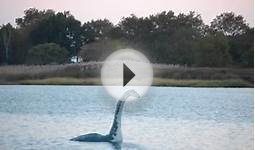Loch Ness Monster found dead
After dragging the carcass back to the shore, the scientists from the Flamingo Park Zoo had sent a telegram to their boss, Don Robinson, and had then quickly loaded the body into their truck and taken off, intending to transport the monster back to the zoo for study. Mrs. Margrete Good, manager of the hotel, later told the press, "The zoologists were thrilled to bits."
But when the local Inverness police heard that the scientists had hightailed it with the Loch Ness Monster, they were infuriated. These were English scientists, after all, removing Scotland's most famous lake monster — upon which depended a vast, lucrative tourist trade.
Immediately the police radioed their colleagues in the Fifeshire County police department, explained the situation, and asked them to chase down the fleeing truck and apprehend the monster-nappers. They cited a 1933 Act of Parliament that prohibited the removal of "unidentified creatures" from Loch Ness.
Sirens wailing, police cars sped off. They soon caught up with the team of scientists. The frightened zoologists readily cooperated with the police, pulling over to the side of the road, and then opening the back of the truck to show the officers what they were carrying. Sure enough, according to the subsequent police report, lying inside the truck was a large "green and scaly" creature.
The police officers, not quite sure what to do next, radioed back to the station for advice. They were told to take the monster to the nearest town, Dunfermline, where it could be examined by Scottish scientists.
The Monster Identified
In Dunfermline, the police searched around for an appropriate scientist to examine the creature, and eventually persuaded Michael Rushton, general curator of the Edinburgh Zoo, to come up and look at it.When Rushton arrived, he walked slowly around the carcass a few times, poked it once or twice, and then announced his verdict. It was indeed a strange creature, but it was no lake monster. Instead, it was a bull elephant seal, whose natural home was the South Atlantic Ocean, thousands of miles away from Scotland. Furthermore, the body showed signs of having been frozen for an extended period of time.
Rushton told the press, "It is a typical member of its species. It's about 3 to 4 years old... I have never known them to come near Great Britain. Their natural habitat is the South Atlantic, Falkland Islands or South Georgia. I don't know how long it's been kept in a deep freeze but this has obviously been done by some human hand."
Confession
How a bull elephant seal came to be floating in Loch Ness remained a mystery until the next day, when a hoaxer stepped forward to confess. John Shields, the Flamingo Park Zoo's education officer, admitted it was his doing.Shields explained that an expedition to the Falkland Islands had recently brought the seal back to the UK. It had lived briefly at the Dudley Zoo, but died soon after arrival. When he learned of this, Shields realized it offered an opportunity to prank his colleagues, who he knew were going up to Loch Ness to search for the monster.
Shields gained possession of the elephant seal, shaved off its whiskers, padded its cheeks with stones, and kept it frozen for a week. Then he dumped it in the Loch and phoned in a tip to make sure his colleagues found it. He timed the prank so that news of the discovery of the Loch Ness Monster would make headlines on April 1 — April Fool's Day, which happened to also be his 23rd birthday.
Headline from The Geneva Times
Shields admitted the joke got out of hand when his colleagues decided to remove the dead animal from Loch Ness and were chased down by the police.
He also noted that the creature wasn't quite as impressive as initial press reports had claimed. It was only nine-feet long and weighed 350-pounds. Still, it had been a very strange thing to find floating in the Loch.
betbom
You might also like








